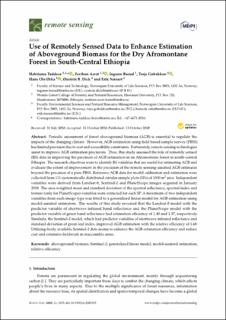| dc.contributor.author | Taddese, Habitamu | |
| dc.contributor.author | Asrat, Zerihun | |
| dc.contributor.author | Burud, Ingunn | |
| dc.contributor.author | Gobakken, Terje | |
| dc.contributor.author | Ørka, Hans Ole | |
| dc.contributor.author | Dick, Øystein B. | |
| dc.contributor.author | Næsset, Erik | |
| dc.date.accessioned | 2021-06-21T06:50:27Z | |
| dc.date.available | 2021-06-21T06:50:27Z | |
| dc.date.created | 2020-11-03T17:22:02Z | |
| dc.date.issued | 2020 | |
| dc.identifier.citation | Remote Sensing. 2020, 12 (20), . | en_US |
| dc.identifier.issn | 2072-4292 | |
| dc.identifier.uri | https://hdl.handle.net/11250/2760288 | |
| dc.description.abstract | Periodic assessment of forest aboveground biomass (AGB) is essential to regulate the impacts of the changing climate. However, AGB estimation using field-based sample survey (FBSS) has limited precision due to cost and accessibility constraints. Fortunately, remote sensing technologies assist to improve AGB estimation precisions. Thus, this study assessed the role of remotely sensed (RS) data in improving the precision of AGB estimation in an Afromontane forest in south-central Ethiopia. The research objectives were to identify RS variables that are useful for estimating AGB and evaluate the extent of improvement in the precision of the remote sensing-assisted AGB estimates beyond the precision of a pure FBSS. Reference AGB data for model calibration and estimation were collected from 111 systematically distributed circular sample plots (SPs) of 1000 m2 area. Independent variables were derived from Landsat-8, Sentinel-2 and PlanetScope images acquired in January 2019. The area-weighted mean and standard deviation of the spectral reflectance, spectral index and texture (only for PlanetScope) variables were extracted for each SP. A maximum of two independent variables from each image type was fitted to a generalized linear model for AGB estimation using model-assisted estimators. The results of this study revealed that the Landsat-8 model with the predictor variable of shortwave infrared band reflectance and the PlanetScope model with the predictor variable of green band reflectance had estimation efficiency of 1.40 and 1.37, respectively. Similarly, the Sentinel-2 model, which had predictor variables of shortwave infrared reflectance and standard deviation of green leaf index, improved AGB estimation with the relative efficiency of 1.68. Utilizing freely available Sentinel-2 data seems to enhance the AGB estimation efficiency and reduce cost and extensive fieldwork in inaccessible areas. | en_US |
| dc.language.iso | eng | en_US |
| dc.rights | Navngivelse 4.0 Internasjonal | * |
| dc.rights.uri | http://creativecommons.org/licenses/by/4.0/deed.no | * |
| dc.title | Use of remotely sensed data to enhance estimation of aboveground biomass for the dry afromontane forest in south-central Ethiopia | en_US |
| dc.type | Peer reviewed | en_US |
| dc.type | Journal article | en_US |
| dc.description.version | publishedVersion | en_US |
| dc.source.pagenumber | 23 | en_US |
| dc.source.volume | 12 | en_US |
| dc.source.journal | Remote Sensing | en_US |
| dc.source.issue | 20 | en_US |
| dc.identifier.doi | 10.3390/rs12203335 | |
| dc.identifier.cristin | 1844657 | |
| cristin.ispublished | true | |
| cristin.fulltext | original | |
| cristin.qualitycode | 1 | |

